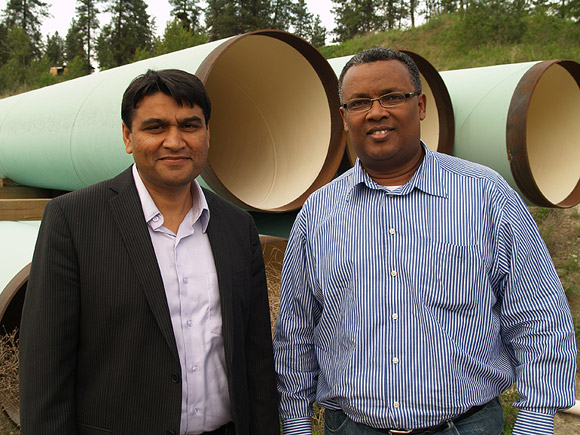
Rehan Sadiq and Solomon Tesfamariam, engineering professors at UBC’s Okanagan campus, have developed a risk-assessment program that can help predict when underground water pipelines may fail.
Further research may expand use into the oil and gas pipeline industry
When it comes to underground infrastructure such as water mains, it’s not a matter of “if” a system is going to fail but “when,” says Solomon Tesfamariam, an associate professor of civil engineering at UBC’s Okanagan campus.
Tesfamariam stresses that municipal infrastructures are at risk because they have been underground, unchecked, for decades. Many small municipalities in BC don’t have the resources to routinely monitor underground systems, he says, so they can only react when a system fails and residents are left without service.
Tesfamariam and fellow UBC professor Rehan Sadiq have developed a computer program that will act as a decision support tool for municipal staff responsible for planning infrastructure repairs or estimating longevity. It is now being tested by the Glenmore-Ellison Improvement District (GEID) and the District of West Kelowna (DWK)—both have signed on to be part of a three-year project.
Research funding from the Natural Sciences and Engineering Research Council of Canada will support five UBC graduate students working specifically with municipal staff to map and assess the overall condition of the underground water mains within the GEID and DWK.
“We are currently in the process of collecting the data,” Tesfamariam says. “And then we will come up with a conceptual tool that will help with regular maintenance. Basically, we want to help municipalities answer the question: ‘What should we be doing now?’”
The idea is to not wait for a water-supply system to fail, but to find a way—via the risk-based decision support tool—to predict where trouble lies and fix it before it breaks down.
Using existing data from geographic information systems and water mains drawings and plans from the GEID and DWK, the inventory of underground pipelines will include age, type of pipe material, past failures and service disruptions, soil properties, pressure, and water quality. Tesfamariam says a municipality can then input this data into the UBC-designed decision support computer program and identify specific at-risk areas.
“If a municipality has our risk-based decision support tool, their residents can expect fewer breaks and fewer service disruptions, while having an improved monitoring system for their water quality,” he says. “It makes sense financially, as they are preventing breaks, not fixing them, and it keeps the infrastructure in check.”
Tesfamariam notes that a recent report by the Canadian Society for Civil Engineering, the Canadian Public Works Association, the Canadian Construction Association, and the Federation of Canadian Municipalities states that the total value of municipal water, wastewater, storm water, and road systems across the country is close to $538 billion. More than $50 billion of that was identified as being in poor or very poor condition, while a further $121 billion worth of infrastructure is listed in fair condition.
It’s a problem that simply can’t be ignored, he adds.
What makes this new technology even more exciting, Sadiq says, is that it can be applied in the oil and gas industry. Reducing the threat of pipeline failure may go a long way to solve many of today’s concerns when it comes to underground oil and gas delivery systems.
“This is just the very beginning of our research and it is certainly valid for water-mains,” says Sadiq. “We are currently using advanced mathematical and statistical techniques and, as research develops, we are confident this can expand into the oil and gas industry with the hope of preventing future environmental disasters and tragedies.”
–30–